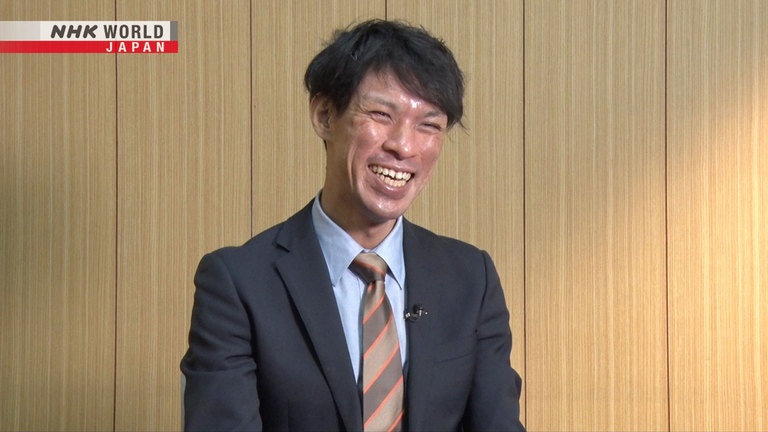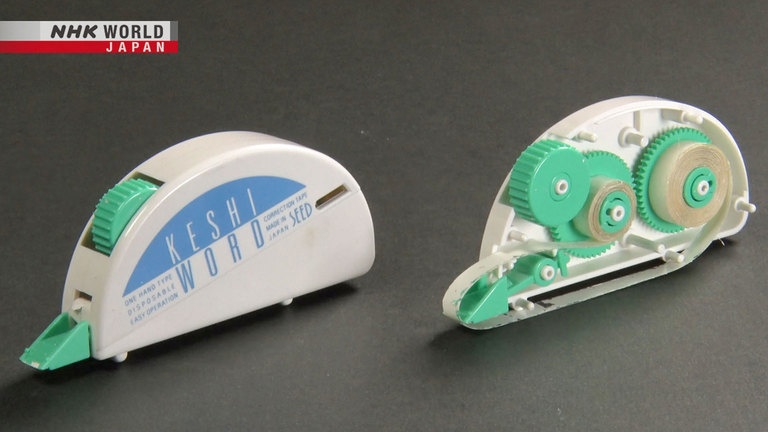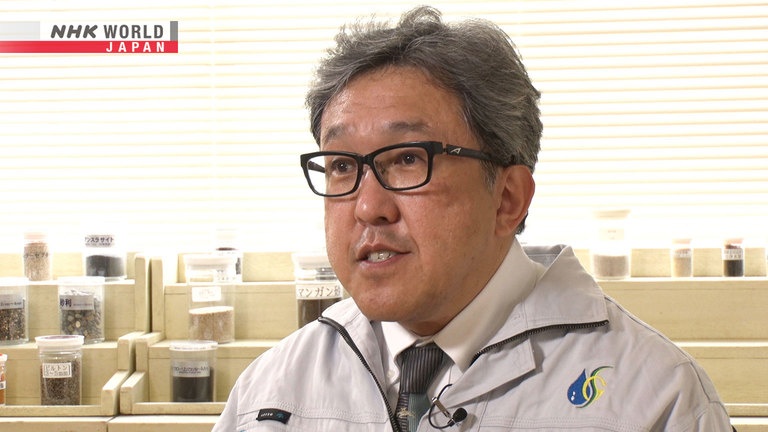Correction Tape / Water Filter Media
The fascinating stories and secrets behind hit Japanese products, plus parts and machines that boast the top share of niche markets. In the first half: the story behind correction tape, the office supply that lets people fix mistakes made in pen. In the second half: water filter media that's used in 80% of Japan's water treatment facilities.



Transcript
"Japan's Top Inventions"
The behind-the-scenes tales of hit products and creations from Japan.
This is "Japan's Top Inventions."
On today's show...
correction tape for fixing written mistakes.
It was inspired by something you might not expect.
Later on the show...
we take a look at this sand.
It's vital to producing tap water.
We'll show you what makes it special.
Hello, welcome to "Japan's Top Inventions."
I'm your host, Jason Danielson.
In the first half of our show, we take you "Behind the Creation."
Today's topic is this.
Correction tape.
Make a mistake while writing?
Just slide the white tape over the bit you got wrong,
and you can write over it.
People all over the world use this to fix mistakes made in pen
that you can't get rid of with an eraser.
This correction tape was developed by a Japanese eraser company.
Its development spanned a long and difficult five years.
A stationery manufacturer in Osaka.
It's a small company of about 60 employees.
Since their founding in 1915, they've continued to produce erasers.
They have a diverse lineup of erasers, both big and small.
This is our first model.
In 1989, the company invented this product.
Correction tape.
By offering a new way to fix written mistakes,
it created new markets around the world.
Our story begins back in 1982.
At the time,
a certain stationery product was popular among Japanese children.
Novelty erasers, shaped like animals, fruit, and popular characters.
These fun erasers stood out from the regular ones,
and children loved them.
They were made by a certain stationery company in Osaka.
Bessho Naoya is currently involved with development at the company.
Here's what he heard about those times.
The company developed puzzle erasers that fit together,
and also ones that smelled like cola.
It was dedicated to crafting brand new erasers,
things that no one had seen before.
However, there was a negative outlook starting to form
during company meetings at that time.
"The demand for erasers is going to decrease."
The reason? The birthrate was expected to decline in Japan.
Fewer children would mean fewer erasers sold.
In addition, many things in offices were becoming automated.
Photocopiers, fax machines,
and word processers all meant less need for erasers.
Instead of handwriting, you'd type on a computer.
So naturally, people will use erasers less.
It seems a lot of employees were worried about this.
With the company's survival at stake,
a new development project was launched.
When considering what kind of product to make,
a team member looked towards this.
Correction fluid, invented in the US.
Brush the white liquid over your mistake,
let it dry, and write over it.
Correction fluid had also made its way to Japan.
It was becoming common in office workplaces.
The company quickly moved to put out its own correction fluid,
but they were late to make it to market.
Sales weren't good,
and they started using up the surplus stock in their own office.
With erasers, we were pioneers,
so sales were good with that kind of lead position.
But with correction fluid, we were followers.
Our warehouse was filled with stacks of boxes filled with correction fluid.
It was a real concern.
Since its founding, the company had specialized in erasing letters.
Could they become pioneers again by developing a new product?
The search was on for fresh ideas.
What would the new product be?
The team started brainstorming with correction fluid on the mind.
"Could it dry any faster?"
"Could it come out flatter after drying?"
These kinds of thoughts were being floated around.
That led to this product idea.
White paper that you could stick over your mistake.
But when they actually tried it out...
If the paper was too thin, you'd be able to see the writing underneath.
When being photocopied, the outline would show up if it was too thick.
I hear there was a lot of trial and error involved in improving it.
Was there a better way?
The team continued to look for options.
They found inspiration from somewhere unexpected.
The mainstay of the company, the erasers.
Take a look at the erasers and you'll find printed lettering.
They're applied using a transfer from a layer of film.
Could they borrow from this technology?
We had an eraser that had printed text on it.
That text was like a thin black layer.
The idea was that if that was made into a white layer instead,
maybe it could be used to cover black text.
And so, the team had their idea for correction tape.
They gathered materials and started prototyping right away.
It's interesting that the printed text on their erasers
helped inspire the correction tape,
but the team still wasn't close to making an actual product.
They would soon run into some unexpected challenges.
The lettering on the erasers used a kind of decal transfer technology.
The letters were carried on a thin clear film.
This was pressed onto the eraser in order to transfer the lettering.
The team proposed an idea based off of this.
A tape with a white layer on clear film.
The white layer would be attached to a strip of film using adhesive.
The bottom would also have adhesive,
so that the white could stick onto the paper and peel from the film.
The width of the film was set at six millimeters,
enough to cover writing.
But there was a problem with length.
If they made the tape long, it became very hard to manage.
The team continued to struggle to find a solution.
Then, one day...
The team looked into cassette tapes,
a popular medium for music at the time.
The two reels inside the plastic housing
were able to store a long length of tape.
The team looked at using something similar to cassette reels
in order to store the tape compactly.
It's common for developers to get inspiration like this
from the world around us.
And so, this was the actual prototype the company made.
Similar to a cassette, tape from one reel wound onto a second reel.
The company successfully secured a patent for this.
Afterwards, as the team continued prototyping, they hit another issue.
How strong to make the adhesive on the tape.
The white layer on the film was covered in adhesive.
But if that adhesive was too strong,
the tape would stick to itself on the reel.
If it was too weak,
the white layer wouldn't stick well to the paper when pressed on.
The adhesive couldn't be too weak or too strong.
It had to come off the film well but also properly stick to the paper.
It was an extremely key point to find that proper balance.
What was the right balance?
The team tested over and over, but they just couldn't find it.
The team was exhausted.
One day, one of the members was on a drive.
The lane lines looked like correction tape.
Anything that was white reminded him of correction tape.
It seems he was thinking about it each day,
to the point where he was seeing it everywhere.
Testing for the adhesive continued on until finally,
5 years in, September 1989...
They found the right strength for the adhesive,
and the correction tape was complete.
The correction tape was made, but one issue remained.
How would they popularize the product?
It was new and unfamiliar.
It would take a lot of explanation to point out the benefits to customers.
The team decided to head for Osaka Station.
They wore clipboards around their necks, calling out to pedestrians.
The plan was to get people to try it for themselves.
In order for people to see the value of correction tape,
they had clipboards with paper to let people try it for themselves.
They thought that'd be the easiest way.
The target was the businessmen in suits.
People who had experience
fixing mistakes with correction fluid would surely see the benefit.
But people just didn't seem to want to stop by.
Everyone seemed busy, and they didn't want to listen.
Those were the people they had to grab.
But one businessman did stop for them.
They handed him the correction tape, and gave him the pitch.
"You can fix mistakes you can't with an eraser. Give it a shot."
The man rolled the tape over the paper.
The lettering disappeared.
A pen was promptly handed over to write over the tape.
If it didn't work well, people would brand their product a failure.
The pen wrote over the tape cleanly.
The businessman was impressed.
It wasn't a liquid like correction fluid,
you just had to apply the tape.
Fixing mistakes was easy, and you could write over it immediately.
That impressed people.
I think they thought this could really improve productivity.
That was how the value of correction tape became recognized.
The street-level marketing created good word of mouth,
and offices in Japan steadily started using the product.
And that was how the correction tape came to be used throughout Japan.
Later, the product spread across the world,
becoming commonly used in offices and homes all over.
How do experts view this invention?
We're joined by Takabatake Masayuki to learn more.
Welcome to the show.
Thank you.
What made correction tape a successful product?
It's a roll of tape that transfers onto paper when pressed on.
The groundbreaking thing was how easy it is to use.
Just slide it over.
It's very handy, so it caught on quick.
There are new versions now,
like ones that perfectly match the color of the paper in a notebook.
With that, it's even harder to notice the tape.
That might seem subtle, but the product is gradually getting better.
What's unique about Japan's stationery and office supplies?
The quality of stationery in Japan, it's always been quite high here.
It has something to do with the Japanese character.
Many people still are very picky
when it comes to how a ballpoint pen writes.
People can tell the difference,
so stationery makers can put things out with subtle differences
and people notice and buy them.
The newest and highest performance items
actually come out in the lowest price range.
For about 20 years,
if we're talking brand new stationery inventions
or existing items taken to the next level,
I would say most of them have come from Japan.
What unique Japanese stationery products
do you find interesting at the moment?
There are new quick-dry brush pens which are popular right now.
These also have very subtle differences,
but users can tell what those are.
Delving very deep into function is part of enjoying stationery.
There's a global movement towards digital,
but Japan is still pursuing better-writing, higher performance pens.
I think that's very interesting.
Thank you for your time. It was nice speaking with you.
My pleasure.
"Top Niche Creations."
Our next segment is "Top Niche Creations."
Today, we're looking at this.
Tap water.
Tap water in Japan comes from rivers and wells.
Water from those sources is purified at water treatment facilities.
80% of the treatment facilities in Japan use this sand.
It might look like plain old sand, but it's actually quite special.
Just how does it work?
We went to find out.
A certain office in the Greater Tokyo Area.
About 70 employees work at this company.
Hello.
An assortment of jars filled with sand are on display.
There are over 100 kinds.
These products help support Japan's tap water infrastructure.
How does it work?
We asked company president Saito Yasuhiro to find out.
The sand acts as a filter to produce tap water.
It's used to filter the water at water treatment facilities.
In Japan, you can turn on the tap and drink the water.
There are over 8,000 water treatment facilities
across the country making clean water.
They take source water from rivers or wells
and remove impurities and microbes.
This company's sand is used at those facilities.
Hundreds of tons of sand are packed into a thick layer.
Source water passes through this and impurities are filtered out.
Just how effective is the sand at filtering?
We were shown a demonstration at the sand processing factory.
This water here contains red soil.
Let's see what happens when it's filtered.
Thirty minutes later...
the sand takes on a slight red tint.
You can see how it's changed from before.
The water that comes out is clear and colorless.
How does this happen?
It's due to the shape of each grain.
If you look closely,
you can see that the grains are all slightly rounded and evenly sized.
The sand grains are 0.6 millimeters big.
If you go smaller, it gets clogged right away and stops filtering.
It's important to keep all the sand at a consistent grain size.
If the sand has different shapes and sizes,
the gaps between the grains also become uneven,
and it functions poorly as a filter.
But with rounded grains of the same size,
the gaps become even, and the sand works perfectly as a filter.
The source material for this sand comes from beaches all across Japan.
It's sifted at the factory,
and the rounded grains which are 0.6 millimeters in size are extracted.
This company excels at being able to accurately sort out the right sand.
We know how the sifting speed, angle,
and nets affect what kind of sand you get.
So the sand here is what you could call top class.
We make it here.
This company owns 80% of the market share for water filter media in Japan.
Here is a picture of the original offices.
It was founded in 1939.
At first, it sold sand for making glass.
After World War II,
they started making filter sand as water infrastructure was set up.
Since then, they've specialized in this area,
providing sand to water treatment facilities throughout Japan.
But in the 60s, they were faced with an issue.
What happens with the used sand?
This is what the new sand looks like.
After years of use, the sand becomes black, like this.
The used sand was disposed of and replaced,
but if this continued indefinitely,
they could run out of sand.
Could the sand be cleaned and recycled?
The company first tried using an agitator to wash the sand.
But this ended up breaking the rounded grains,
ruining the filtering capability.
How could they prevent the grains from breaking?
They looked at research being done at universities,
and they stumbled on something promising.
"Singing sand," which makes noise as you step on it.
At a certain university, there was a professor researching singing sand.
There was a beach that became polluted,
and the sand there stopped singing.
The professor wanted to find a way to restore the singing sand.
They put sand in a jar with water,
turned it sideways, and put it on rollers,
letting it go round and round.
The grains would rub against themselves, and clean the dirt off.
We learned this from their research.
That led them to develop their own sand washing machine.
This is a small demo unit.
Let's turn it on.
The screw inside lifts the sand up, and drops it.
This causes the sand grains to rub against themselves,
cleaning off the dirty surfaces without breaking the grains.
This is the sand before cleaning.
And here is the washed sand.
You can see how it has been restored.
These are all our patents from around the world.
With this technology, the company has secured patents around the world.
Their goal is to continue to help provide clean water worldwide.
It's said that there are well over a billion people
who don't have access to clean water in the world.
We want to use our company's technology
to contribute to a safe water environment
for people from places all over.
This company not only supports the water supply in Japan,
they're also helping to provide clean drinking water around the world.
This is a new portable water treatment system they developed.
It has a screw component and sand inside
which removes impurities from pond water and makes it safe to drink.
It's been used in places such as the Philippines and Laos.
I'm looking forward to seeing
just where this Japanese technology will travel to next.
That's all for this episode of "Japan's Top Inventions."
We'll leave you with what came next for the correction tape
from the first half of the show.
See you next time! And stay inventive.
(The company developed the correction tape in 1989.)
(Afterwards, it licensed its patent, allowing others to create similar products.)
(New stationery products inspired by correction tape have also appeared.)
(This is the patent from the prototype, obtained some 30 years ago.)
(This is where it all started.)
Our company developed correction tape.
I think it's our purpose to keep putting out new products
that people haven't seen before.
Things that people will respond to.
We're going to keep trying to show people something new.
We'll do our best.